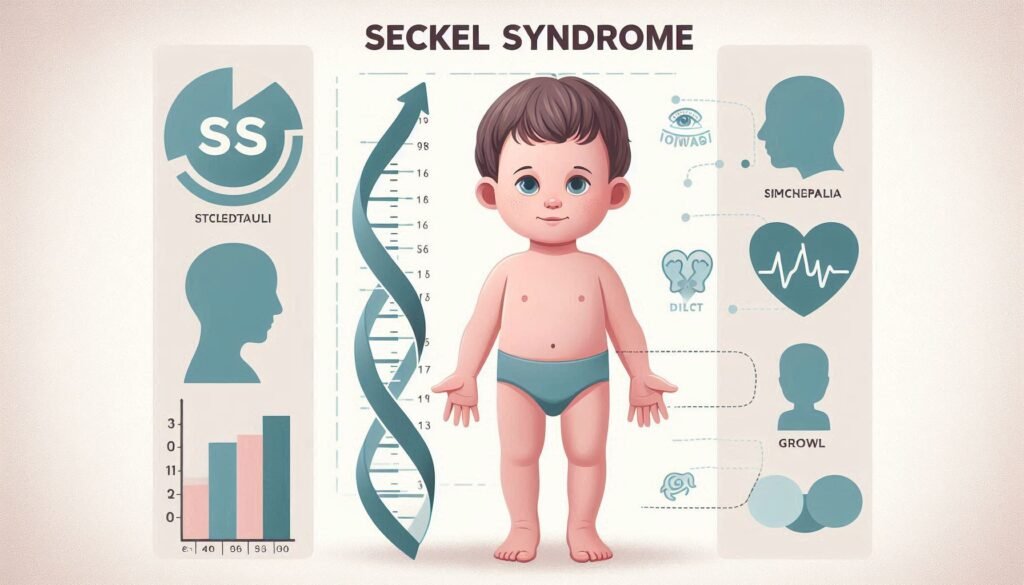Seckel Syndrome is a rare genetic disorder that falls under the umbrella of primordial dwarfism. This intriguing condition, first identified in the mid-20th century, presents a unique set of challenges and characteristics. Individuals with Seckel Syndrome often struggle with significant growth deficiencies and distinctive facial features, making awareness and understanding essential for affected families.
In this comprehensive guide, we will delve into the intricacies of Seckel Syndrome—from its historical discovery to its genetic roots. We’ll explore how it affects daily life, highlight key symptoms to recognize, and discuss treatment options available today. Whether you’re searching for information due to personal connections or simply seeking knowledge about this uncommon disorder, our aim is to provide clarity on all aspects of Seckel Syndrome while raising awareness about those living with it.

What is Seckel Syndrome? Understanding the Basics
Seckel Syndrome is a genetic disorder characterized by severe growth deficiencies and physical anomalies. It usually manifests as dwarfism, with individuals experiencing significantly shorter stature than their peers.
The condition is classified as primordial dwarfism, which means it arises from developmental issues during early stages of fetal growth. Those affected typically exhibit microcephaly, resulting in an abnormally small head size.
“Allan-Herndon-Dudley Syndrome: How Does It Impact Brain Development?”
In addition to height differences, Seckel Syndrome presents various distinctive features. These may include large eyes, a beak-like nose, and prominent cheekbones. Despite these challenges, many individuals lead fulfilling lives with appropriate support.
Understanding Seckel Syndrome involves recognizing the diverse ways it affects development and health. The complexity of this disorder emphasizes the importance of awareness for families and healthcare providers alike.
Historical Context: Helmut Seckel and the Syndrome’s Discovery
Helmut Seckel, a German physician, played a pivotal role in the identification of Seckel Syndrome. His work during the 1960s brought attention to this rare genetic disorder characterized by significant growth deficiencies.
“What Are The Early Signs of AIDS? Understanding HIV Progression”
Seckel first described the syndrome in detail after observing patients with distinctive physical features and developmental challenges. His meticulous documentation provided crucial insights into its manifestations and inheritance patterns.
The syndrome was named after him due to his pioneering contributions. As research progressed, it became clear that Seckel Syndrome is part of a larger spectrum of primordial dwarfism disorders.
Today, Helmut Seckel’s legacy endures within the medical community as researchers continue to explore the complexities surrounding this condition. Understanding his contributions helps frame ongoing studies aimed at improving diagnosis and treatment for those affected by this rare disorder.
Genetic Basis: Multiple Genes Involved in Seckel Syndrome
Seckel Syndrome has a complex genetic foundation. Research indicates that multiple genes contribute to its development. These mutations disrupt normal growth and cellular processes.
“How Does Babinski-Nageotte Syndrome Affect The Brainstem?”
Key genes implicated include SCKL1, which plays a role in cell division and regulation. Other associated genes are involved in DNA repair mechanisms, essential for maintaining genomic stability.
Variations in these genes lead to the disorder’s hallmark features. The interplay between different genetic factors creates variability in symptoms among affected individuals.
Understanding this genetic basis is crucial for advancing diagnosis and treatment options. Genetic testing can reveal specific mutations, aiding families seeking answers about their condition.
This intricate web of genetics highlights the importance of ongoing research into Seckel Syndrome’s biological underpinnings.
Prevalence and Epidemiology: How Common is Seckel Syndrome?
Seckel Syndrome is an extremely rare genetic disorder. Its prevalence remains largely unknown, with estimates suggesting it occurs in approximately 1 in every 10 million live births.
“What Causes Baller-Gerold Syndrome? Guide to Rare Cranial Disorder”
This condition has been documented across various populations worldwide, but specific data indicating demographic variations are limited. The lack of comprehensive epidemiological studies makes understanding its true incidence challenging.
Though both males and females appear to be equally affected, the rarity of Seckel Syndrome can complicate diagnosis and management. Families often face difficulties finding support and information due to its infrequent occurrence.
Ongoing research aims to shed light on this elusive disorder. Increased awareness among healthcare professionals may improve early detection rates and enhance patient outcomes moving forward.
Clinical Features: Recognizing the Characteristic Signs and Symptoms
Seckel Syndrome presents a range of distinct clinical features that can aid in its identification. A prominent characteristic is severe microcephaly, where the head circumference is significantly smaller than average for age and sex. This noticeable trait often leads to concerns about brain development.
“Why Does Bardet-Biedl Syndrome Cause Multiple Health Issues?”
Individuals with Seckel Syndrome typically exhibit dwarfism, resulting from growth deficiencies. Their height remains considerably below standard growth charts, which can contribute to challenges in social interactions.
Facial characteristics are also telling signs. Patients may have large eyes or a beak-like nose, giving their face a unique appearance. These traits often draw attention but can vary widely among individuals.
Additionally, developmental delays are common. Children might experience setbacks in both cognitive and motor skills compared to their peers. Awareness of these symptoms can facilitate timely diagnosis and better support for those affected by this rare disorder.
Growth Deficiency: Understanding the Severe Microcephaly and Dwarfism
Growth deficiency is a hallmark of Seckel Syndrome, characterized by both severe microcephaly and dwarfism. Individuals with this condition often exhibit a significantly reduced head size compared to their peers. This abnormal brain growth can affect overall cognitive function.
“How Does Bartter Syndrome Affect Kidney Function? Expert Guide”
Dwarfism in Seckel Syndrome is not just about height; it encompasses various aspects of physical development. Affected individuals typically have shorter stature than average, often resulting from disrupted bone growth patterns.
The severity of these growth deficiencies varies among individuals. Some may experience more pronounced challenges than others. Understanding these intricacies can aid caregivers and healthcare providers in offering targeted support and interventions.
Monitoring growth milestones is crucial for managing health outcomes related to this disorder. Regular assessments ensure that any additional complications or developmental delays are addressed promptly, allowing for better quality of life and care strategies tailored to individual needs.
Facial Characteristics: Distinctive Features of Seckel Syndrome
Individuals with Seckel Syndrome often exhibit distinctive facial characteristics that are key to its recognition. One of the most notable features is a disproportionately large head relative to the body, which contributes to an overall appearance of dwarfism.
“What Triggers Behcet’s Syndrome & How Can It Be Managed?”
Facial features include a prominent forehead and a beaked nose. These traits give the face a unique profile that can aid healthcare providers in making an initial assessment. Additionally, many individuals have wide-set eyes, which may appear almond-shaped.
The ears in those affected by Seckel Syndrome tend to be low-set and can vary in size. This combination of facial elements contributes significantly to the recognizable presentation associated with this rare disorder.
These unique characteristics play an essential role not only in diagnosis but also in understanding more about the condition’s genetic underpinnings and clinical management strategies.
Developmental Delays: Cognitive and Motor Impairments
Developmental delays are a significant aspect of Seckel Syndrome. Children with this condition often experience challenges in both cognitive and motor skills.
Cognitive impairments can vary widely. Some individuals may exhibit mild learning difficulties, while others face more pronounced challenges that affect their daily functioning. Early intervention is crucial to help maximize their potential.
“Why Does Bloom Syndrome Increase Cancer Risk? Complete Guide”
Motor skill delays are also common. Fine motor skills, such as grasping small objects or writing, may take longer to develop. Gross motor skills like walking or running might be delayed as well.
Therapies tailored for these specific needs can make a difference. Physical therapy often focuses on improving mobility and coordination. Occupational therapy helps enhance fine motor skills through engaging activities.
These interventions not only support development but also boost confidence in children living with Seckel Syndrome.
Skeletal Abnormalities: Bone and Joint Issues in Seckel Syndrome
Skeletal abnormalities are a significant aspect of Seckel Syndrome. Individuals with this condition often experience various bone and joint issues that can impact mobility and overall health.
These skeletal features may include short stature, which is common in dwarfism disorders. The limbs might be disproportionately short compared to the torso. Such physical traits can affect daily activities.
Joint problems also arise frequently in those affected by Seckel Syndrome. Flexibility may be limited, leading to stiffness or discomfort during movement. This restriction can hinder participation in physical activities.
Moreover, some patients exhibit scoliosis or other spinal deformities. These conditions require careful monitoring as they may lead to further complications over time.
Understanding these skeletal challenges is crucial for developing appropriate management strategies tailored to improve quality of life for individuals living with Seckel Syndrome.
Diagnostic Criteria: How Seckel Syndrome is Identified
Diagnosing Seckel Syndrome involves a careful evaluation of clinical features and genetic testing. Physicians typically begin with a thorough physical examination to identify characteristic signs, including short stature and microcephaly.
Medical history plays an essential role in diagnosis. Understanding familial patterns can provide critical insights into the genetic basis of the disorder.
Advanced imaging techniques, such as MRI or CT scans, may help assess brain structure abnormalities commonly associated with the syndrome.
Genetic tests are crucial for confirming the diagnosis. These tests target specific mutations within genes known to be linked to Seckel Syndrome.
Collaboration among specialists is often necessary for accurate identification. Geneticists, pediatricians, and neurologists work together to interpret findings comprehensively.
Early recognition allows families to seek interventions that improve overall quality of life for individuals affected by this rare condition.
Genetic Testing: The Importance of Molecular Diagnosis
Genetic testing plays a crucial role in diagnosing Seckel Syndrome. By analyzing an individual’s DNA, healthcare providers can identify mutations in specific genes associated with this disorder.
Molecular diagnosis offers clarity for families seeking answers. It confirms whether the characteristic features they observe are due to Seckel Syndrome or another condition altogether.
Early identification through genetic testing also aids in planning proper care and interventions. Understanding the genetic basis allows doctors to tailor treatment strategies that address individual needs.
Moreover, knowing the exact genetic cause empowers families. They gain insight into potential risks for future pregnancies and can make informed decisions regarding reproductive options.
As research advances, genetic tests become more refined. This evolution enhances accuracy in identifying rare disorders like Seckel Syndrome, leading to improved patient outcomes and better quality of life for those affected.
Prenatal Detection: Options for Early Identification
Prenatal detection of Seckel Syndrome can be crucial for early identification and management. Various testing methods are available to expectant parents.
Non-invasive prenatal testing (NIPT) is one option. This blood test analyzes fetal DNA circulating in the mother’s bloodstream. It can detect genetic anomalies associated with dwarfism disorders, including Seckel Syndrome.
Another method is amniocentesis. This invasive procedure involves sampling amniotic fluid from the uterus. While it carries some risks, it provides a definitive diagnosis by analyzing fetal chromosomes.
Chorionic villus sampling (CVS) offers another approach. Performed earlier than amniocentesis, CVS samples placental tissue to assess genetic conditions quickly.
Genetic counseling plays an essential role too. Professionals guide families through testing options and implications of results, helping them make informed decisions throughout pregnancy.
Accessing these screening methods allows families to prepare better for potential challenges ahead related to Seckel Syndrome.
Differential Diagnosis: Distinguishing from Other Primordial Dwarfism Disorders
Differentiating Seckel Syndrome from other forms of primordial dwarfism is crucial for accurate diagnosis and management. Various genetic disorders present similar characteristics but differ significantly in their underlying causes.
One key condition is Turner syndrome, which primarily affects females and involves a missing or incomplete X chromosome. While both conditions may exhibit short stature, individuals with Turner syndrome often have distinct physical traits like webbed necks and broader chests.
Another condition to consider is Achondroplasia, the most common form of skeletal dysplasia. Though it leads to short stature as well, its features include disproportionate limb size rather than the microcephaly observed in Seckel Syndrome.
Additionally, Ellis-van Creveld syndrome presents with dwarfism alongside heart defects and dental abnormalities. Careful clinical evaluation helps distinguish these syndromes based on specific signs and family history, guiding appropriate treatment strategies for those affected by Seckel Syndrome.
Treatment Approaches: Managing Symptoms and Improving Quality of Life
Managing Seckel Syndrome requires a multifaceted approach tailored to individual needs. Treatment focuses on alleviating symptoms and enhancing the quality of life for those affected.
Regular monitoring by a team of healthcare professionals is essential. This may include pediatricians, neurologists, and geneticists who can address various health concerns as they arise.
Therapeutic interventions play a crucial role. Physical therapy can help improve motor skills and mobility, while speech therapy supports communication development.
Nutritional support is vital to ensure adequate growth and overall well-being. A dietitian can create meal plans that cater to specific dietary needs.
Parents and caregivers also benefit from counseling services. Navigating the challenges associated with Seckel Syndrome can be overwhelming, making emotional support an important aspect of care.
Creating an inclusive environment allows individuals with Seckel Syndrome to thrive despite their unique challenges.
Growth Hormone Therapy: Potential Benefits and Limitations
Growth hormone therapy has emerged as a potential treatment for individuals with Seckel Syndrome, particularly in addressing growth deficiencies. The primary aim of this therapy is to stimulate growth and enhance overall height.
One significant benefit of growth hormone administration is the possibility of increasing final adult height. This can result in improved self-esteem and social interactions for affected individuals. Additionally, enhanced muscle mass and bone density may lead to better physical health outcomes.
However, there are limitations associated with this treatment. Not all patients respond positively to hormone therapy, making it less effective for some. Moreover, the long-term effects are not well-studied in those with Seckel Syndrome specifically.
Potential side effects include joint pain or swelling and increased insulin resistance. Regular monitoring by healthcare professionals is essential to mitigate risks while maximizing benefits from the therapy.
Supportive Care: Addressing Developmental and Medical Needs
Supportive care plays a crucial role in managing the needs of individuals with Seckel Syndrome. Due to the range of symptoms associated with this disorder, tailored interventions are essential for promoting well-being.
Therapies such as physical and occupational therapy can help improve motor skills and daily functioning. Speech therapy is also valuable for addressing communication challenges that may arise.
Regular medical check-ups ensure health issues are monitored closely. Specialists often collaborate to provide comprehensive care, focusing on both developmental milestones and potential complications.
Educational support is vital too. Individualized education plans (IEPs) can accommodate learning differences, enhancing academic experiences.
Families benefit from counseling services, which offer guidance on navigating the complexities of life with Seckel Syndrome. These resources create a supportive environment that fosters growth and resilience for affected individuals and their families alike.
Complications: Potential Health Risks Associated with Seckel Syndrome
Individuals with Seckel Syndrome face various potential health complications that require vigilant monitoring. Due to the nature of this genetic disorder, they often experience severe microcephaly and dwarfism, leading to unique health challenges.
Cardiovascular issues are common among individuals with this syndrome. The underdevelopment of blood vessels can create a risk for hypertension or other heart-related problems.
Additionally, compromised immune function may lead to increased susceptibility to infections. Regular medical check-ups and vaccinations are crucial for maintaining health in these patients.
Vision and hearing impairments can also arise due to structural abnormalities in the eyes and ears. Early intervention is critical for addressing these sensory deficits effectively.
Orthopedic complications such as scoliosis or joint deformities frequently occur. These skeletal issues may necessitate physical therapy or even surgical interventions over time.
Living with Seckel Syndrome: Daily Challenges and Coping Strategies
Living with Seckel Syndrome poses unique challenges. Individuals often face daily hurdles related to growth, development, and health management.
Mobility can be affected due to skeletal abnormalities. This may necessitate the use of adaptive equipment or assistance in navigating physical spaces.
Social interactions might also require special attention. Children with Seckel Syndrome may experience teasing or isolation due to their appearance and developmental delays.
Coping strategies are essential for families and individuals alike. Support groups provide a platform for sharing experiences and advice. Engaging in community activities tailored for those with disabilities fosters inclusion.
Establishing routines can help manage symptoms effectively. Regular medical check-ups ensure that complications are addressed promptly while therapy sessions can aid cognitive and motor skills development.
Educating peers about Seckel Syndrome promotes understanding and empathy, enhancing social support networks vital for emotional well-being.
Research Developments: Current Studies and Future Directions
Research into Seckel Syndrome is progressing, with scientists uncovering more about its genetic underpinnings. Recent studies have focused on the specific genes associated with the syndrome, enhancing our understanding of how these mutations affect growth and development.
Current efforts are exploring potential treatments aimed at alleviating some symptoms of Seckel Syndrome. Researchers are investigating gene therapy as a possible avenue to address the underlying genetic causes. Clinical trials may provide insights into effective interventions for those affected by this disorder.
Furthermore, multidisciplinary approaches combining genetics, pediatrics, and developmental psychology aim to improve support systems for families dealing with Seckel Syndrome. These collaborations help ensure that individuals receive comprehensive care tailored to their unique needs.
As awareness grows within both medical communities and the public sphere, future research will likely open new doors in treatment options and quality-of-life improvements for those living with Seckel Syndrome. The journey towards better understanding continues as we strive to enhance life experiences for individuals impacted by this rare condition.


